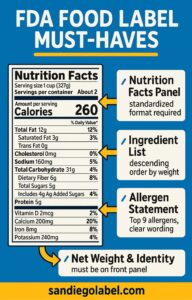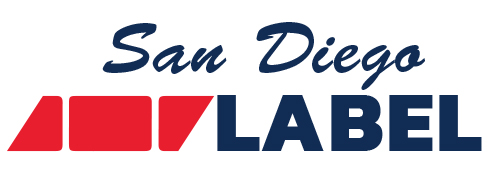
Intro
Food packaging is more than branding — it’s also about following strict FDA labeling rules. In fact, missing even one requirement can put your product at risk of being pulled from shelves.
In this post, we’ll break down the essential FDA food labeling requirements step by step. By the end, you’ll know exactly what to look for when designing or reviewing your packaging.
Nutrition Facts Panel
First and foremost, the Nutrition Facts panel must follow the FDA’s standardized format.
-
It must include serving size, calories, macronutrients, and key micronutrients.
-
Furthermore, the FDA regulates font size, line spacing, and bolding.
👉 In other words, you can’t simply “style” the panel — it has to match the FDA format exactly.
Ingredient List
In addition to the Nutrition Facts, every food label must include a complete ingredient list.
-
Ingredients must be listed in descending order by weight.
-
All names must use the common name consumers recognize (for example, “sugar” instead of “sucrose”).
This helps customers clearly understand what’s in your product without confusion.
Allergen Labeling (FALCPA Rules)
However, the FDA doesn’t stop at ingredients. Under FALCPA rules, you must also declare the Top 9 allergens:
-
Milk, eggs, fish, shellfish, tree nuts, peanuts, wheat, soybeans, and sesame.
For example, if your product contains casein, the label must say “Contains: Milk.” This clarity protects consumers with allergies and reduces liability for your brand.
Net Quantity & Statement of Identity
Next, your label must display the net weight or volume on the principal display panel (PDP) — usually the front of the package.
In addition, the statement of identity (the product name) must be easy to read, prominent, and in the required font size. This ensures that consumers immediately understand what the product is and how much they’re buying.
Placement & Readability Rules
It’s not just what you include — it’s also where and how.
-
All mandatory information must appear in a conspicuous location.
-
Moreover, minimum font sizes apply depending on package dimensions.
-
Labels must remain readable even on curved or small surfaces.
Therefore, when designing labels for bottles, jars, or other irregular packaging, compliance checks are even more important.
Common Mistakes We See
Unfortunately, we see the same compliance mistakes over and over:
-
Nutrition panel not following FDA formatting.
-
Allergen disclosure missing or too vague.
-
Font size too small for net quantity.
-
Ingredient list hidden or broken across panels.
These errors may seem small, but collectively they can cost businesses thousands in wasted packaging and relabeling.
Final Thoughts
To sum up, getting FDA food labels right isn’t optional — it’s essential. The rules exist to protect both consumers and businesses, and they’re strictly enforced.
If you’re launching a new food product, or refreshing your packaging design, make compliance part of your process early. That way, you can avoid costly mistakes and keep your product moving.
👉 At San Diego Label, we help food brands print labels that not only look great but also meet FDA requirements — so your products stay on shelves without worry.
